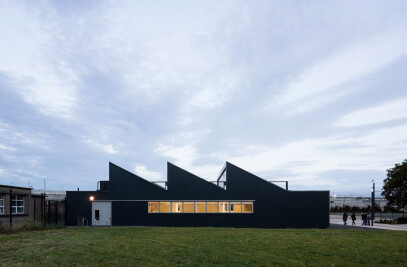On this extension to a 1930s semi-detached house in the suburbs of Dublin, our clients were interested in forming a new room that was a continuation of the gentle formality of the main house; rather than extend with a scaleless, rootless annex. The existing kitchen was positioned, as was typical of the time, in a utilitarian dark north-west corner of the original house, with windows onto a dark side passageway set a metre above the garden. Our objective was to reposition the kitchen in a manner that reflected its centrality to family life without forming a rupture between the work we added and the house we had been gifted with.
Previously, the entrance hallway was cluttered with provisional storage and coat stands that offered an ad-hoc atmosphere that only served to devalue its centrality to the home. We enhanced its stature by relocating storage and lining the walls with a wainscotting formed with simple inch-wide painted poplar beads, extending the central axis of the house through an oak lined lobby, concealing a mirrored wet bar, with a bright white terrazzo floor.
In the view ahead, three terrazzo steps lead down to a generously sized dining room and kitchen. The view to the garden overlooks a circular dining area wrapped with sweeping curved glass. The curved form creates a calm captured space, removed from the foot traffic of people passing through to the garden, and was inspired by the Victorian glass conservatories at Ballyfin and Dunfillan of Richard Turner, the Irish born Iron Founder and creator of the Palm houses in Kew Gardens and Belfast Botanic Gardens.
The extension faces east, so to allow sunlight to reach deep into the room long, high clerestory windows bring in sunlight until mid-afternoon, and open to exhaust warm air in summer.
Externally, forest green slender metalwork supporting gutters and concealing downpipes adds an enrichment and delicacy in a manner similarly deployed to the external joinery on the front façade fascias and bay windows of the 1930s original house. Inside new oak joinery to a bespoke design conceals all the appliances, pantry and utility door in an extension of the oak cabinetry in the lobby, while the same white terrazzo forms work surfaces and protective wall linings.
In replanning the home, the kitchen is now at the heart of family life whilst the original house is renewed and given space to breathe and be valued.
Material Used:
Facade cladding: Wall Tiles, Rombini, Mutina
Doors: Aluminium, Reynaers SL38
Windows: Aluminium, Reynaers SL38

































